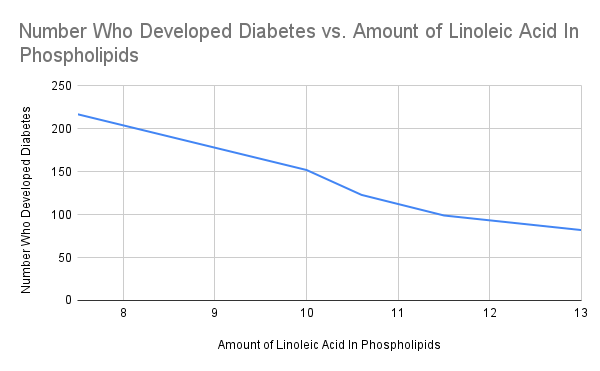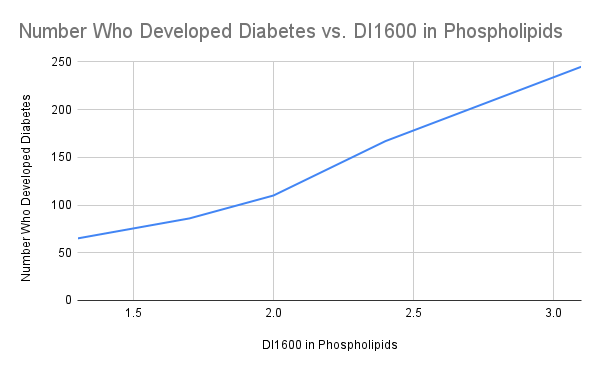This is from the EPIC Potsdam study in Germany, which looked at the association between membrane phospholipid composition, diet and type 2 diabetes risk.1 Read it and weep.

It looks like linoleic acid prevents diabetes after all. Time to shut down the blog, run out and buy some corn oil.
KIDDING!
Remember what happened to the pigs who got extra PUFA in their diet? They got torpid, turned on De Novo Lipogenesis and all of the newly manufactured oleic acid diluted out the linoleic acid.
The superpower of modern lean pig breeds is linoleic acid accumulation
Modern American pigs have been selected for optimum lean growth and they are very resistant to obesity. I once had the distinct displeasure of raising a group of landrace hogs along with my mulefoot crosses. They all lived in the same pastures eating the same feeds. The mulefoot crosses packed on an inch and a half of nice firm backfat while the landrace hogs wound up with a half inch of soft, greasy backfat.
I have said that linoleic acid is the spark but torpor is the fire. Modern breeds of pig are flame retardant.
If pigs who are prone to obesity get enough PUFA, they switch on lipogenic genes and start cranking out oleic acid. Linoleic acid accumulates to a point, but once they start getting fat, oleic acid predominates.
When genetically FAT pigs are fed enough PUFA, their DI1600 goes up and up and their linoleic acid goes DOWN.2
| Fat Pigs | Control Diet | Low Omega 3 Soy Oil | Soybean Oil |
| Linoleic Acid | 14.3 | 25.8 | 11.6 |
| Oleic Acid | 35.4 | 31.5 | 38.8 |
| DI1600 | 5.4 | 6.1 | 7.9 |
Pigs who resist obesity accumulate linoleic acid forever. Pigs fed 39% sunflower seeds in their diet ended up with 54% linoleic acid in their fat. That is a little more than the linoleic acid content of corn oil.3
| Corn Oil | Lean Pigs Fed 39% Sunflower Seeds | |
| Linoleic Acid | 52% | 54% |
When genetically LEAN pigs are fed PUFA, their DI1600 goes down and down and their linoleic acid goes UP.3
| Lean Pigs | 0% Sunflower Seeds | 13% | 26% | 39% |
| Linoleic Acid | 13.9 | 30.3 | 45.6 | 53.9 |
| Oleic Acid | 35.3 | 27.4 | 22.6 | 20.7 |
| DI1600 | 11.6 | 8.5 | 6.5 | 6.0 |
Lean pigs are all spark and no flame.
Diabetes In Humans
This divides the world into two types: those who accumulate linoleic acid and those who become torpid. If you accumulate linoleic acid you are unlikely to get diabetes. If you switch on torpor and the lipogenic genes, you will do de novo lipogenesis, dilute out the dietary linoleic acid with homemade oleic acid and get diabetes. Just like in pigs, the lean people are flame retardant.

The DI1600 IS associated with diabetes risk in actual, walking-around humans. Linoleic acid content is inversely associated. Quite strongly.
Test Your DI1600
The OmegaQuant Complete test can tell you your DI1600. When you get your results, divide palmitoleic acid (the first number in the cis-Monounsaturated Fatty Acids section) by palmitic acid (the second number in the Saturated Fatty Acids section) and multiply it by 100. The first time I took the test, before supplementing with Sterculia Oil, my DI1600 was a 12. Not a 1.2 – an actual 12. I was way off the chart.
- 1.Kröger J, Zietemann V, Enzenbach C, et al. Erythrocyte membrane phospholipid fatty acids, desaturase activity, and dietary fatty acids in relation to risk of type 2 diabetes in the European Prospective Investigation into Cancer and Nutrition (EPIC)–Potsdam Study. The American Journal of Clinical Nutrition. Published online October 27, 2010:127-142. doi:10.3945/ajcn.110.005447
- 2.Potu RB, Lu H, Adeola O, Ajuwon KM. Metabolic markers in Ossabaw pigs fed high fat diets enriched in regular or low α-linolenic acid soy oil. Nutrition & Metabolism. Published online 2013:27. doi:10.1186/1743-7075-10-27
- 3.Marchello MJ, Cook NK, Johnson VK, Slanger WD, Cook DK, Dinusson WE. Carcass Quality, Digestibility and Feedlot Performance of Swine Fed Various Levels of Sunflower Seed1. Journal of Animal Science. Published online May 1, 1984:1205-1210. doi:10.2527/jas1984.5851205x

But what happens to those that accumulate LA and don’t get fat? Perhaps worse inflammation and other diseases? Maybe Torpor is protective in some ways?
I’m not suggesting it’s a good idea.
When you say accumulating LA…..but don’t get fat , do you mean that the LA is almost all beta oxidized and doesn’t follow the “rules” of low ROS and hyperphagia?
http://high-fat-nutrition.blogspot.com/2021/05/random-musings-on-uncoupling.html?m=0
Peter from hyperlipid recently proposed that PUFA also cause uncoupling. At low levels the pathological insulin sensitivity, hyperphagia and weight gain predominate. As PUFA increases (dietary increase or accumulation) the uncoupling effect increases and takes over.
Perhaps the genetically lean pigs are more prone to uncoupling when exposed to PUFA. They would maintain insulin sensitivity, overeat due to heat loss, accumulate a high % LA, but also not get fat.
Maybe not the right question relative to this post, but what are your thoughts on the protein part of hogs? What if you follow the “Ted Naiman” school of more protein and don’t focus on fat.
Scroll to the bottom of this: https://fireinabottle.net/the-fire-lifestyle/
Under the “Eat” column it lists Brad’s low PUFA pork, but also lean chicken and pork “trimmed of all visible fat”. Not gonna speak for him, but I don’t think he has a problem with it based on this context.
Just like this article shows, pork fat from conventionally raised/bred animals “can” have just as much or more linoleic acid than corn oil. So if you wouldn’t eat a tablespoon of corn (canola or soybean for that matter) why would you eat a tablespoon of pork fat?
This has been HARD for me, I used to pound bacon and pork chops, fry my eggs in bacon grease, eat pork rinds by the truckload, and advocate for it.
Now I eat very little pork and only white meat chicken. I lost a bunch of weight (60lbs) several years ago, but could never get that last bit off my waist/love handles, and thanks to Brad I know why.
Brad, if you read this, low PUFA pork rinds would be manna from heaven. #TakeMyMoney
After reading (and re-reading) Brad’s awesome blog, some articles, and watching video’s (mostly youtube) about what a natural disaster linoleic acid is for the human body I’ve pretty much cut it all out. I mean, if you eat you’re gonna get some PUFA, even if all you eat is grass fed/finished beef, but I’m avoiding it now much more so than I was even just a few weeks ago.
I would also love low PUFA pork rinds! I cannot buy any of the fresh meat because I live in Switzerland. I wish there were more options to purchase meat that could be shipped here.
I just read that duck fat “contains 35.7% saturates, 50.5% monounsaturates (high in linoleic acid) and 13.7% polyunsaturated fats”. I’m guessing it’s off the table now.